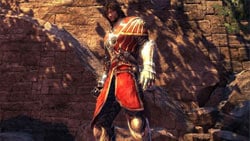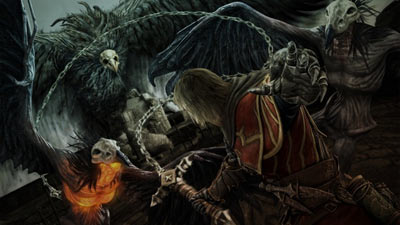Castlevania: The Adventure
In most pop-cultural circles, “reboot” is often thought of as a dirty word. In Hollywood, the term is tossed around far too easily, and outside of, say, Casino Royale, Batman Begins, and Star Trek, more often than not yields middling results.

Rarely one to stray far from the film industry, games have started to follow suit, and while there are probably more success stories rebooting game series—Crystal Dynamics taking over the Tomb Raider franchise and Ubisoft’s gorgeous 2008 one-off Prince of Persia come to mind—die hard fans and fanboys are much, much harder to please, particularly when there’s a threat of someone playing god with their favorite series. So Mercury Steam’s announcement last year that they were jointly developing a new 3D Castlevania alongside Kojima Productions didn’t exactly sit well with a lot of the hardcore fans of Konami’s premiere vampire slaying franchise. Worse was the fact that the developers actually proclaimed the so-called Lords of Shadow a reboot, taking the series in a bold and modern new direction.
Now, any Castlevania fan that’s been following its progression since the inception of 3D knows that the third dimension has never been kind to the Belmont clan. With a disastrous start on the N64, the first 3D Castlevania was quickly dubbed a laughingstock, and while later 3D efforts on PS2 were much better attempts, 2005’s Curse of Darkness was still far from a perfect three-dimensional rendition. You might even say that Castlevania’s had a split personality since its muddy 64-bit debut, with the “true” line of the series following the handheld 2D GBA and DS titles (which for all intents and purposes took up Symphony of the Night’s non-linear mantle and ran with it). Let’s face it—all other technical or gameplay issues aside, the reason 3D Castlevania has never sat well with fans is because it hasn’t been Symphony of the Night with a 360-degree range of movement. Even a 3D entry that held as much promise as Lords of Shadow—a game that’s received Hideo Kojima’s blessing—has been met with doubt and dismay to the point where some fans (and even critics) have complained that it isn’t actually Castlevania. Yeah, Lords of Shadow is a definitely a reboot, and certainly a take on the series that owes as much to God of War, Devil May Cry, and even Uncharted as it does its own lineage. Also, it is decidedly not Symphony of the Night in 3D. But guess what? This is still every bit a Castlevania game.

Lords of Shadow does operate with a somewhat different rule book than you might be used to seeing in a Castlevania game, though. At a glance, you might mistake the game for a gothic God of War, and to some degree that’s right. But rather than simply moving from setpiece to setpiece, with Kratos only stopping to slaughter whoever might get in his way, Lords of Shadow has more of the feel and pacing of a modern adventure game. Sadly, this means the non-linear “which way do I go?” moments have been severely curbed, giving way to more focused design, including the occasional puzzle that may range from easy to a bit obtuse. Even so, Lords of Shadows’ levels are often large in size and scope, and the developers have done a great job fooling you into believing you’re accomplishing a lot of exploration by obscuring objectives, a la Uncharted 2. The game itself is divided into chapters, which are then chopped into levels. Though this is generally a no-no for the series, the number of sweeping vistas and slow zooms out from massive, ancient ruins or imposing architectural works, Gabriel Belmont encounters can be overwhelming; Lords of Shadow isn’t just a huge game, it’s one that can be wearyingly epic. If you need any proof of that, just wait till you get to the second Titan boss.

What makes this Castlevania more of an adventure game comes down to some specifics with the game’s mechanics. First up is the combat; probably the biggest bone of contention among skeptics. Lords of Shadow’s battles will feel awfully familiar with anyone who’s played a recent combo-based action game (I might point out that the first PS2 Castlevania, Lament of Innocence, utilized a very similar design, however).

Experience earned can be used to buy new combo moves and special abilities (for your dual light and dark magic systems), so if you’re expecting any of Symphony’s action-RPG elements, or, say, the ability to equip new weapons or armor, you’re probably going to be disappointed; add in some quicktime-style killing moves and it seems like Gabriel might be gunning for Kratos’ job. There’s more going on here than just action, though. The aforementioned exploration element is a mix between Uncharted and Tomb Raider, and allows you some moments of relative quiet in between sessions of killing everything in sight. There’s plenty of combat to go around, but it often occurs within the natural parameters of exploring your surroundings rather than just locking you in a room full of beasties until you’ve slain and hewn your way free. Even mounting beasts, an action-design move ripped from God of War III and Dante’s Inferno, has been largely re-appropriated to more than just using a giant monster to crush your foes. Wargs can leap over distances Gabriel can’t; trolls and warthogs can smash through barriers; giant spiders can rip open doors and create passages with their silk web. Although it isn’t true MetroidVania-style design, there are also a number of blocked passages and out-of-reach items that you can’t access until you’ve upgraded your equipment (again, think Lament of Innocence); thankfully, the game lets you return to previous levels from the world map at your leisure. The game’s puzzles are integrated organically into its overall pacing as well; the first chapter’s handhold may be somewhat misleading, but as you progress, traps and mechanisms are explained less and less, with the developers only offering vague hints at how to move forward, if they offer any at all. All of this adds up to a drawn-out feel that’s more deliberate than the breakneck speed of an action game.
The game’s presentation doesn’t hurt, either. It’s a rare event when Konami releases a big-budget entry in a long-running signature franchise like this one, and they really went all out with Lords of Shadow. Robert Carlyle and Patrick Stewart round out a solid voice cast, though Patrick Stewart’s omniscient, between-level narration far outshadows Gabriel’s laconic responses. True to form, the narrative in the game is sparsely expounded on, but what is present isn’t bad, thanks to an underlying mystery unfolding in the background. No one plays Castlevania for its story anyway, but recruiting the caliber of talent they did for the game speaks volumes to tremendous amount of effort the developers have put into this project. As if that weren’t enough, Lords of Shadow is one of the most flat-out gorgeous games of this console generation, right up there with Uncharted 2 and the just-released Enslaved. Aside from the sheer scope, environmental effects, lighting, varied level design, and beautiful character and enemy models show an astounding amount of detail, rich with color and depth; perhaps this was Kojima’s influence. Everywhere there are little touches, like frogs hopping a marshy swamp area, or the precise way that, say, a bloody stump looks and moves after being chopped off by an evil butcher. There’s even the occasional moment where the engine looks pretty close to CG, and the action seems to run at a constant 60 FPS. Not bad, coming from the developer responsible for American McGee’s Scrapland and Clive Barker’s Jericho.
If you’re still on the fence about Lords of Shadow, the one thing you have to decide on is whether or not you’re adverse to change. This isn’t Castlevania like you’re used to, and at times may feel more like Lords of the Rings or Soul Reaver. The core “Castlevania” bits appear gradually, but the series’ feel is there, even if you’re not always in a castle (as are the prerequisite ghosts, werewolves, vampires, imps, goblins, possessed toys, zombies, wargs, trolls, dullahan, and harpy-types, to name a few). Lords of Shadow borrows liberally from other series, including a couple of truly awesome Shadow of the Colossus-style boss fights, but the end result is good enough that the overlap shouldn’t matter—after all, Symphony stole its design from Metroid anyway. The point is, if you’ve got an open mind, there’s a lot to like here. If the game is a success, which it should be, hopefully there will be more non-linear elements in the next game. I would also love to see more huge boss monsters and some lite-RPG elements, like the option to use different weapons. And while we’re at it, the dev team could figure out a way to canonize this new world; supposedly Lords of Shadow isn’t proper Castlevania, despite taking place about fifty years prior to the Lament of Innocence’s Belmont “origin” tale. Still, if this is a glimpse into the future of Castlevania, I don’t see a whole lot of reasons we should complain.
RATING OUT OF 5 RATING DESCRIPTION 4.8 Graphics
Lords of Shadow alternates from lush, colorful and sweeping to dismal and moody, but it is always jaw-dropping. 4.5 Control
Although this is basically the God of War control scheme, a few choice mappings with the shoulder buttons really make controlling Gabriel near-effortless. Only the occasional precision placement can throw you off. 4.8 Music / Sound FX / Voice Acting
The soundtrack is less Michiru Yamane and more Hans Zimmer, but it’s amazing nonetheless. Robert Carlyle and Patrick Stewart are keynotes (particularly the latter) among a uniformly excellent cast. 4.5 Play Value
Castlevania as a modern, linear adventure game. It’s a little different, but the formula works. Also, this game is massive—expect to log at least 18-20 hours before you reach the end. 4.6 Overall Rating – Must Buy
Not an average. See Rating legend above for a final score breakdown.
Game Features:
